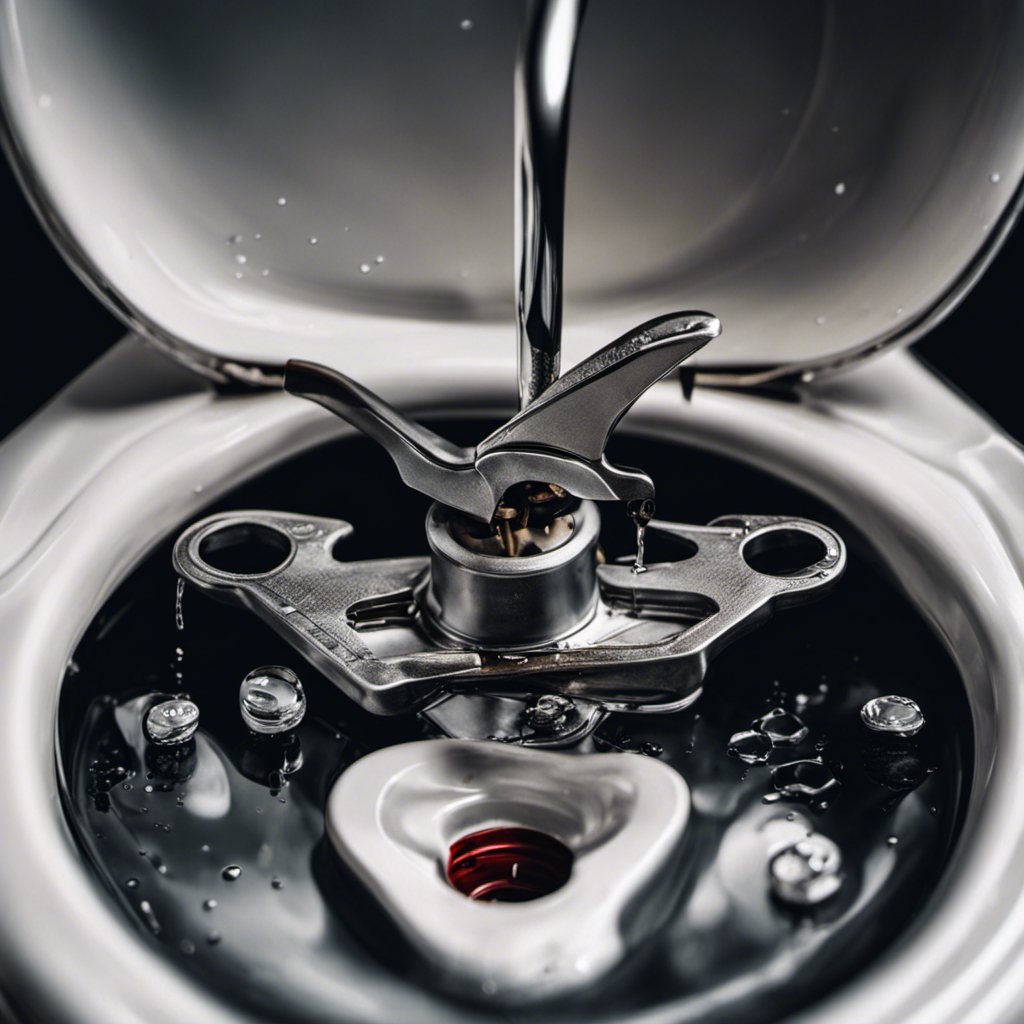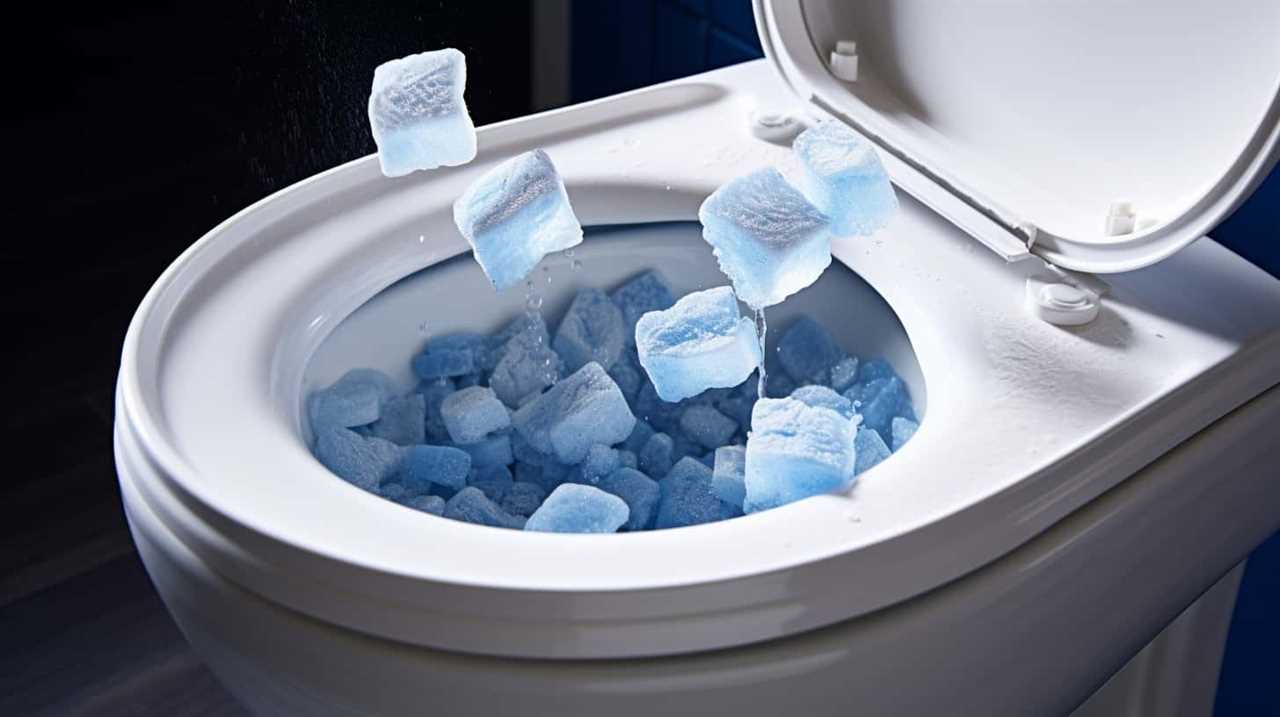As a seasoned plumber, I have encountered my fair share of leaky toilets. While it may seem like a small inconvenience, a leaky toilet can lead to bigger problems if left unaddressed.
In this article, I will guide you through the process of fixing a leaky toilet with precision and expertise. By identifying the source of the leak, shutting off the water supply, and making necessary repairs, you’ll be able to tackle this common issue and restore peace to your bathroom.
Let’s get started!
Key Takeaways
- Identifying the source of the leak is crucial for fixing a leaky toilet. This can include inspecting the wax ring, supply line, and toilet tank for damage or wear, and replacing faulty components.
- Shutting off the water supply is necessary before making any repairs. This can be done by locating the water valve behind the toilet and turning it clockwise. Adjusting the fill valve or replacing it may also be necessary to adjust water pressure and prevent further leaks.
- A leaky flapper valve can cause constant running of water in the toilet. Checking and possibly replacing the flapper valve can help stop this. Turning off the water supply, locating the flapper valve in the toilet tank, adjusting the chain length, and inspecting the valve for damage are important steps in fixing this issue.
- A faulty fill valve may need to be repaired or replaced. This can involve inspecting the fill valve for damage, turning off the water supply, flushing the toilet, detaching the water supply line, and removing the old fill valve from the tank. Checking for cracks, leaks, or debris in the fill valve and adjusting water pressure may also be necessary.
Identifying the Source of the Leak
Now, you need to figure out where the leak is coming from.
Identifying the source of the leak is crucial in fixing a leaky toilet. There are several common causes that could be responsible for the leak.
One possible cause is a faulty wax ring, which is located between the toilet and the flange.
Another common cause is a loose or damaged supply line, which connects the toilet tank to the water supply valve.
Additionally, a cracked toilet tank or bowl can also lead to leaks.
To troubleshoot the issue, start by inspecting the wax ring, supply line, and toilet tank for any visible signs of damage or wear.
Tighten any loose connections and replace any faulty components.
Remember to turn off the water supply before attempting any repairs.
Shutting off the Water Supply
First, you’ll need to locate the valve to shut off the water supply to your toilet. It is typically located on the wall behind the toilet, near the floor. Turn the valve clockwise to shut off the water supply.
This step is crucial before attempting any repairs on a leaky toilet. Once the water supply is shut off, you can proceed with fixing the issue.
To adjust the water pressure, you may need to adjust the fill valve or replace it if necessary. Additionally, using plumber’s tape can help create a tight seal when connecting any water supply lines. Make sure to wrap the tape clockwise around the threaded connections before tightening them.
These steps will help ensure a successful repair and prevent any further leaks.
Fixing a Leaky Flapper Valve
To stop the constant running of water in your bathroom, you’ll need to check and possibly replace the flapper valve. The flapper valve is responsible for sealing the toilet tank and preventing water from continuously flowing into the bowl.
Here are four steps to fix a leaky flapper valve:
- Turn off the water supply to the toilet by shutting off the valve located behind the toilet.
- Remove the toilet tank lid and locate the flapper valve at the bottom of the tank.
- Check the chain length connected to the flapper valve. Adjust it if necessary to ensure proper sealing.
- Inspect the flapper valve for any signs of damage or wear. If it’s cracked or deteriorated, replace it with a new one.
By following these steps, you can effectively fix a leaky flapper valve and stop the water from continuously running in your toilet.
Now, let’s move on to repairing a faulty fill valve.
Repairing a Faulty Fill Valve
Inspect the fill valve for any signs of malfunction or damage, and if necessary, replace it with a new one.
The fill valve is responsible for regulating the water level in the toilet tank.
To begin, turn off the water supply to the toilet and flush it to drain the tank.
Next, detach the water supply line from the fill valve.
Use a wrench to loosen the nut holding the valve in place and remove it from the tank.
When examining the fill valve, check for any cracks, leaks, or debris that may be causing the issue.
If the water pressure is too high, you can adjust it using the valve’s adjustment screw.
Additionally, inspect the float arm, which is connected to the fill valve, to ensure it moves freely without any obstructions.
Once the fill valve is replaced or repaired, you can proceed to the next step of replacing the wax ring.
Replacing the Wax Ring
Before proceeding with the replacement of the wax ring, make sure to turn off the water supply to the toilet and drain the tank by flushing it. This step is crucial to ensure a smooth and mess-free installation of a new toilet. Once you have completed these preliminary steps, you can proceed with the following:
-
Remove the old wax ring: Carefully lift the toilet bowl off the flange and remove the old wax ring. Make sure to clean the flange thoroughly before installing the new one.
-
Install the new wax ring: Place the new wax ring onto the flange, making sure it is centered and aligned properly.
-
Reinstall the toilet bowl: Carefully lower the toilet bowl onto the wax ring, ensuring that it is properly aligned with the flange. Apply gentle pressure to create a good seal.
-
Secure the toilet bowl: Fasten the bolts and nuts to secure the toilet bowl to the floor, using a wrench or pliers. Make sure not to overtighten.
Frequently Asked Questions
Can I Use Any Type of Wax Ring When Replacing the Wax Ring on a Toilet?
Yes, you can use different types of wax rings when replacing the wax ring on a toilet. However, it is not recommended to use a rubber gasket instead of a wax ring for a toilet.
How Do I Know if I Have a Faulty Fill Valve?
When my toilet started constantly running, I had no idea it was a faulty fill valve causing the problem. Luckily, I learned the symptoms and how to troubleshoot it. Let me share my knowledge with you.
What Tools Do I Need to Fix a Leaky Flapper Valve?
To fix a leaky flapper valve, you’ll need a few common tools. First, gather a pair of pliers, an adjustable wrench, and a replacement flapper valve. These troubleshooting tips will help you get started.
Is There a Specific Way to Shut off the Water Supply to a Toilet?
When the water supply valve to my toilet got stuck, I panicked. But with a little know-how, I was able to shut off the water. Here’s how to do it: locate the valve, turn it clockwise until it stops.
Are There Any Common Mistakes to Avoid When Identifying the Source of a Leak in a Toilet?
Common mistakes to avoid when identifying the source of a leak in a toilet include not thoroughly checking all components, overlooking small leaks, and not understanding the different parts of the toilet. Here are some troubleshooting tips.
Conclusion
In conclusion, fixing a leaky toilet is a relatively simple task that can save you money on water bills and prevent water damage to your bathroom. By identifying the source of the leak, shutting off the water supply, and repairing or replacing the necessary components, you can effectively stop the leak.
Interestingly, according to the Environmental Protection Agency, a leaky toilet can waste up to 200 gallons of water per day. This staggering statistic highlights the importance of promptly fixing any leaks to conserve water and protect the environment.
Remember, with a little know-how and some basic tools, you can easily tackle this common household issue.










